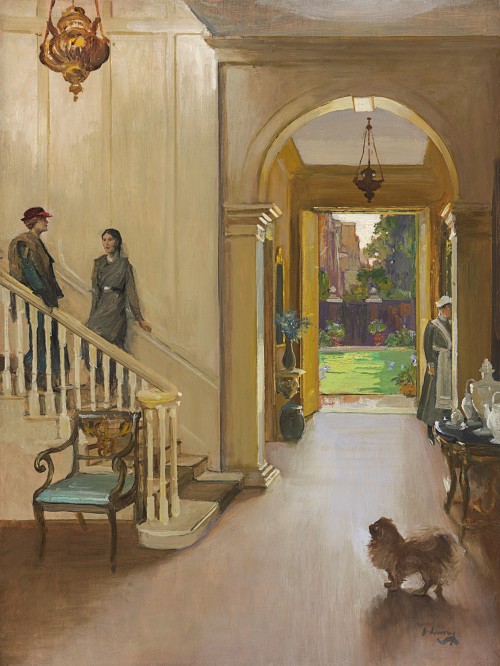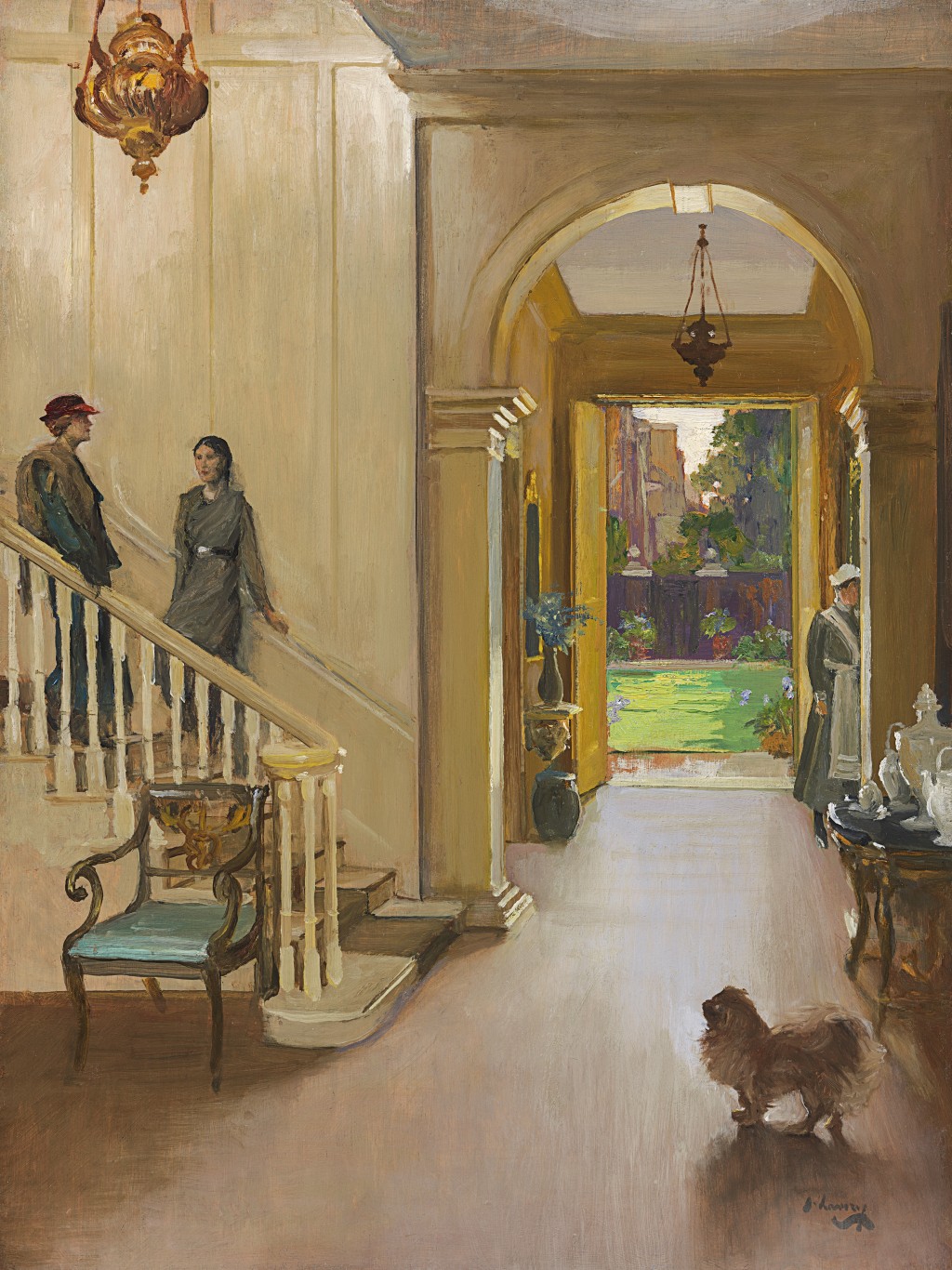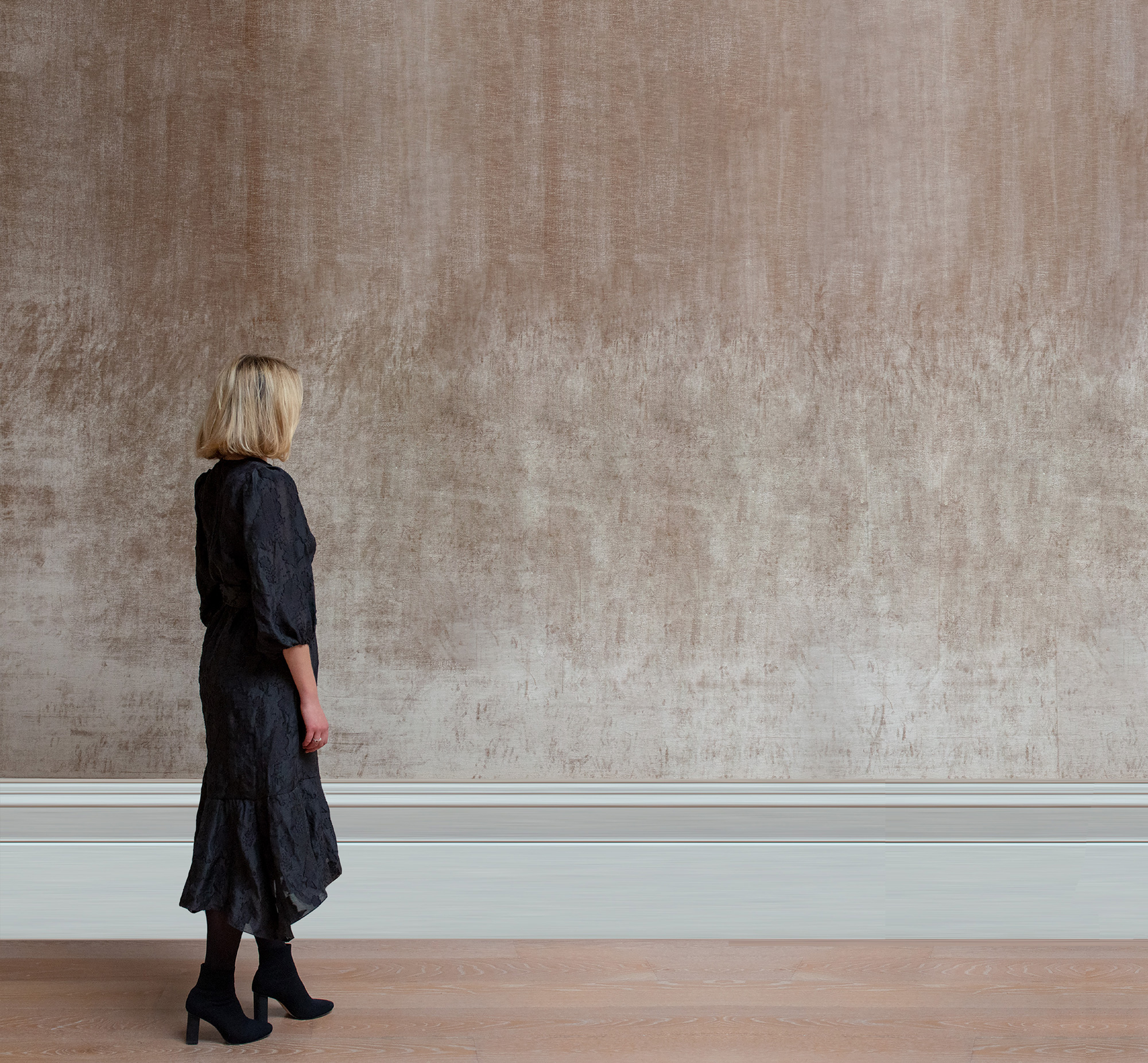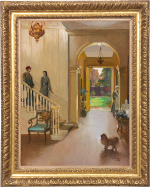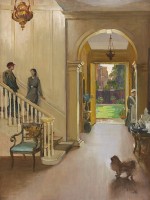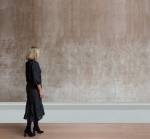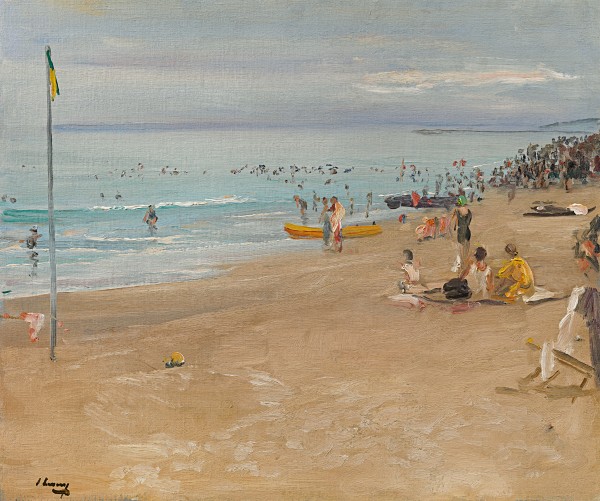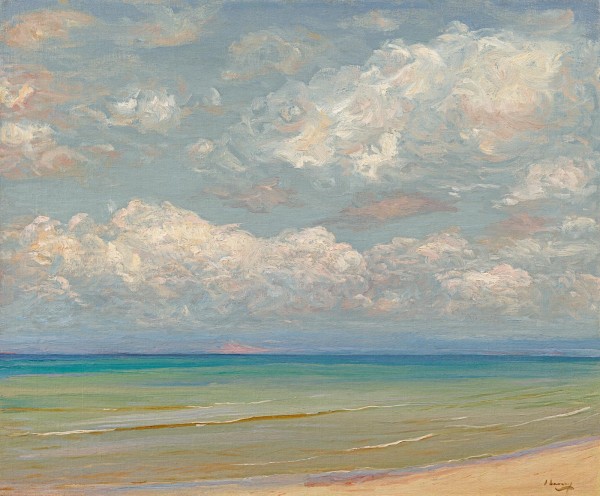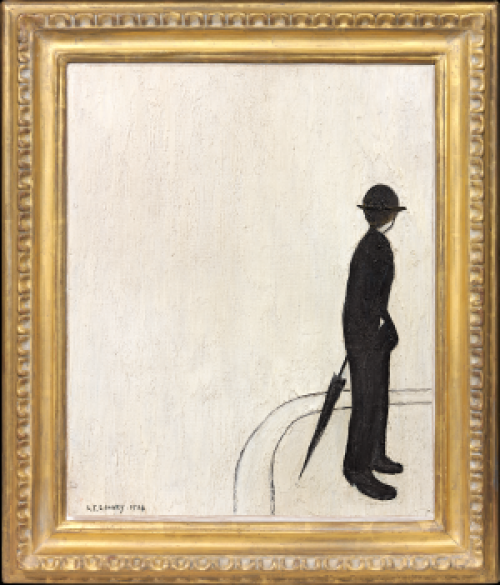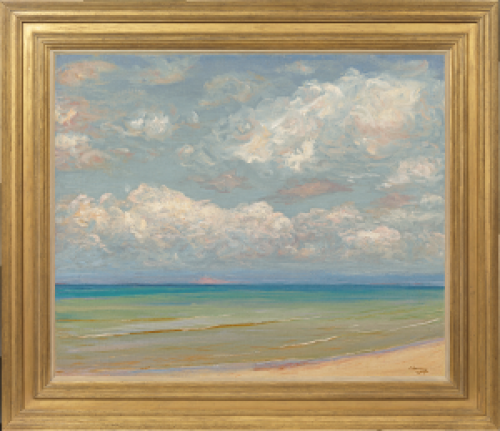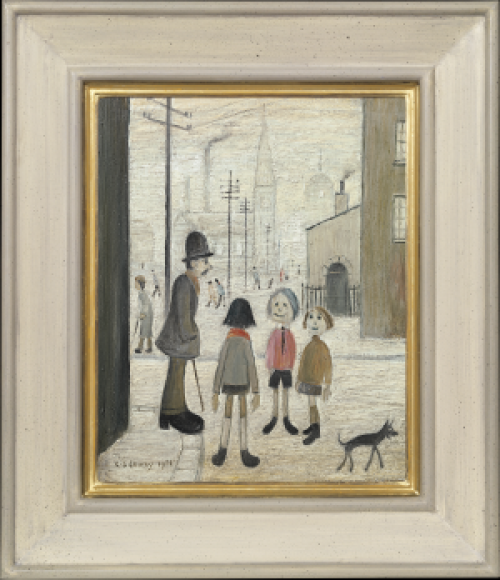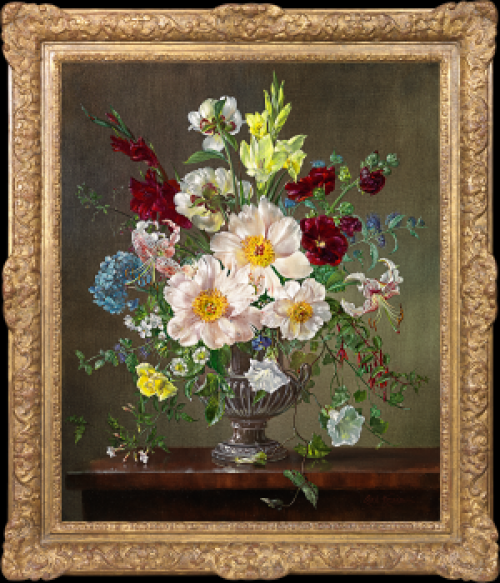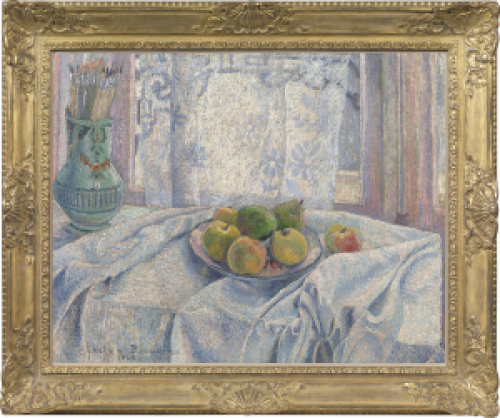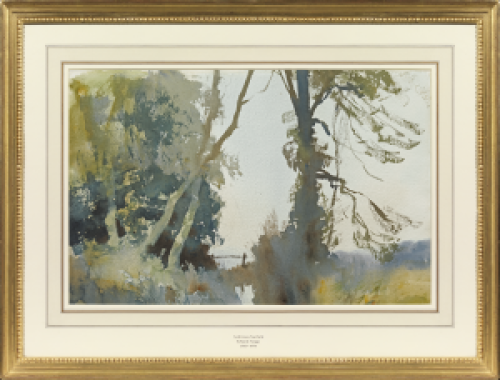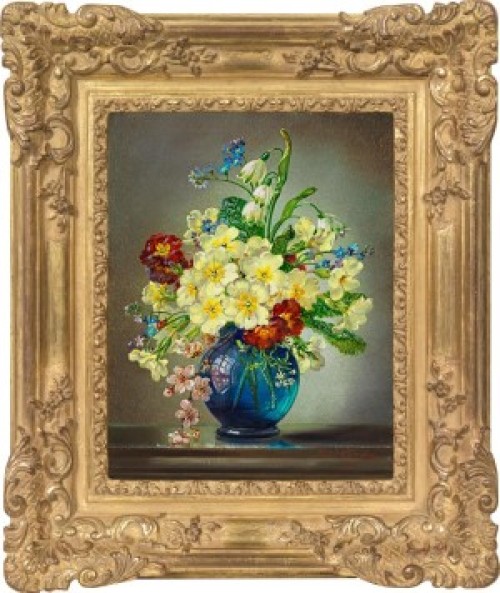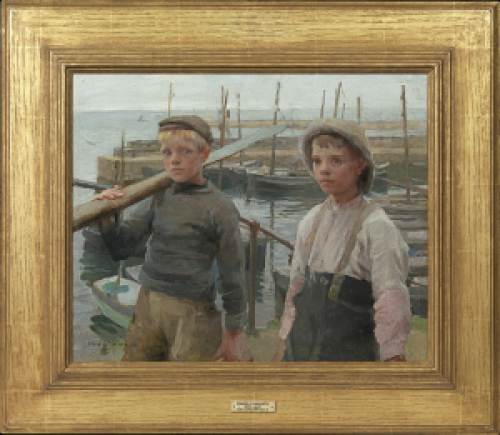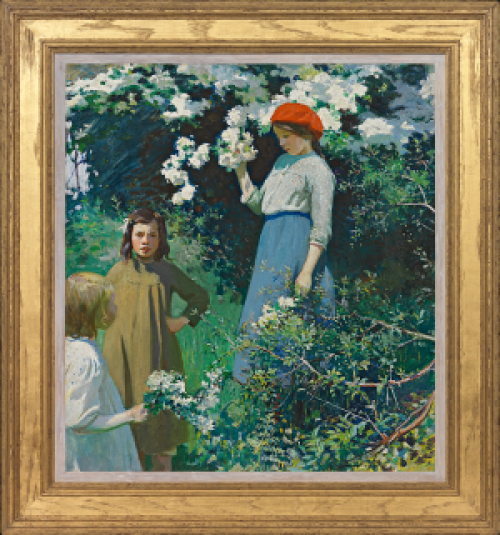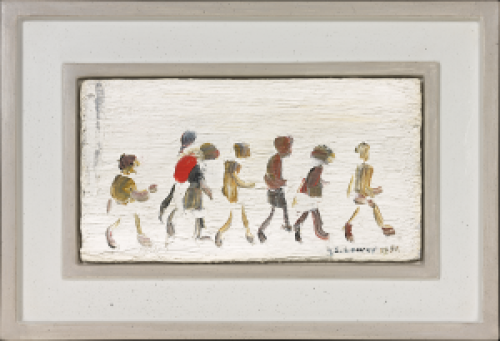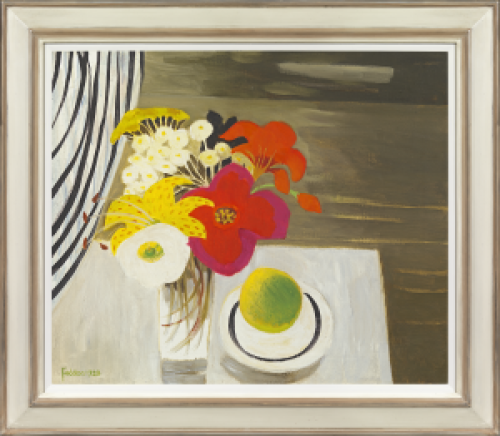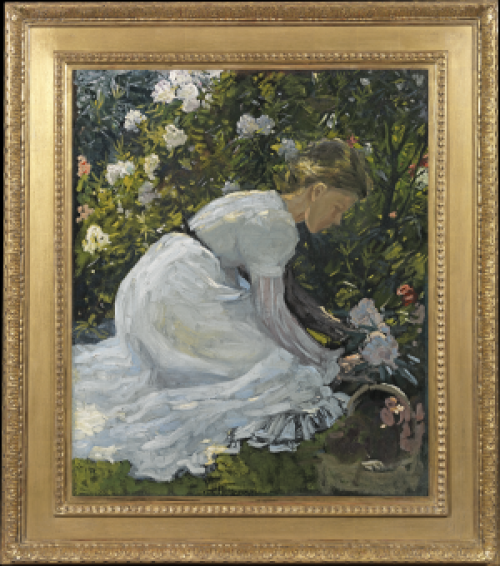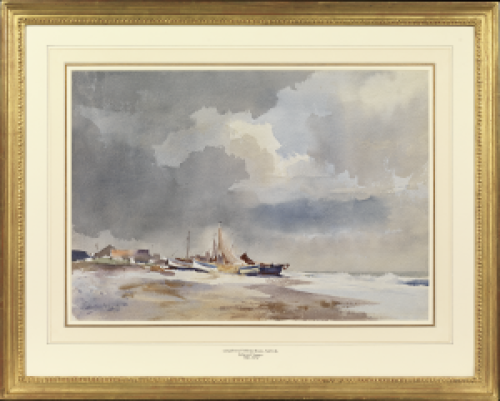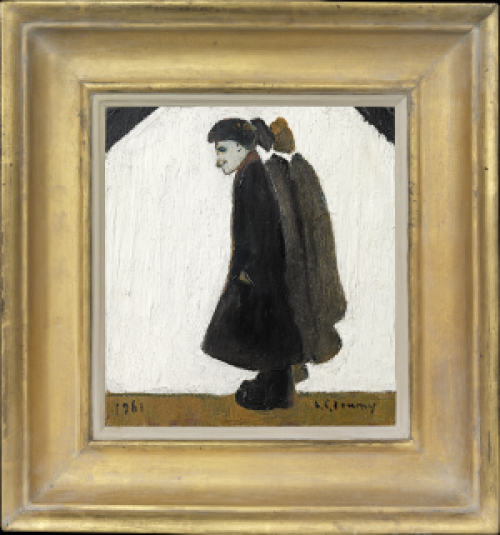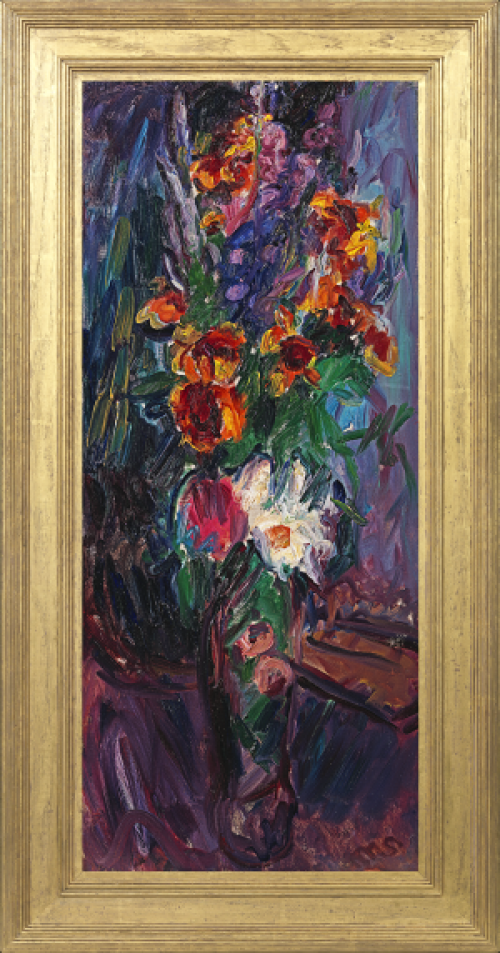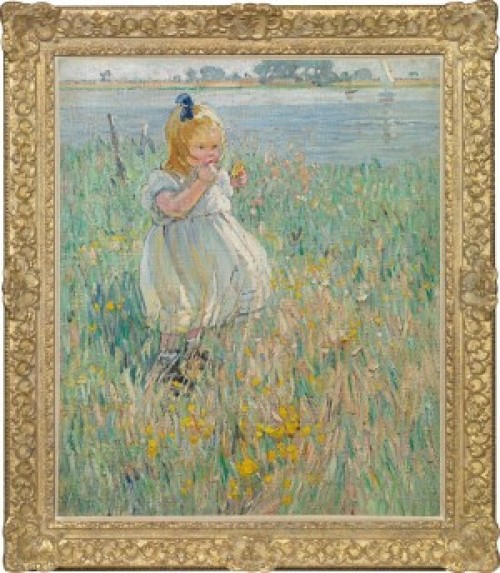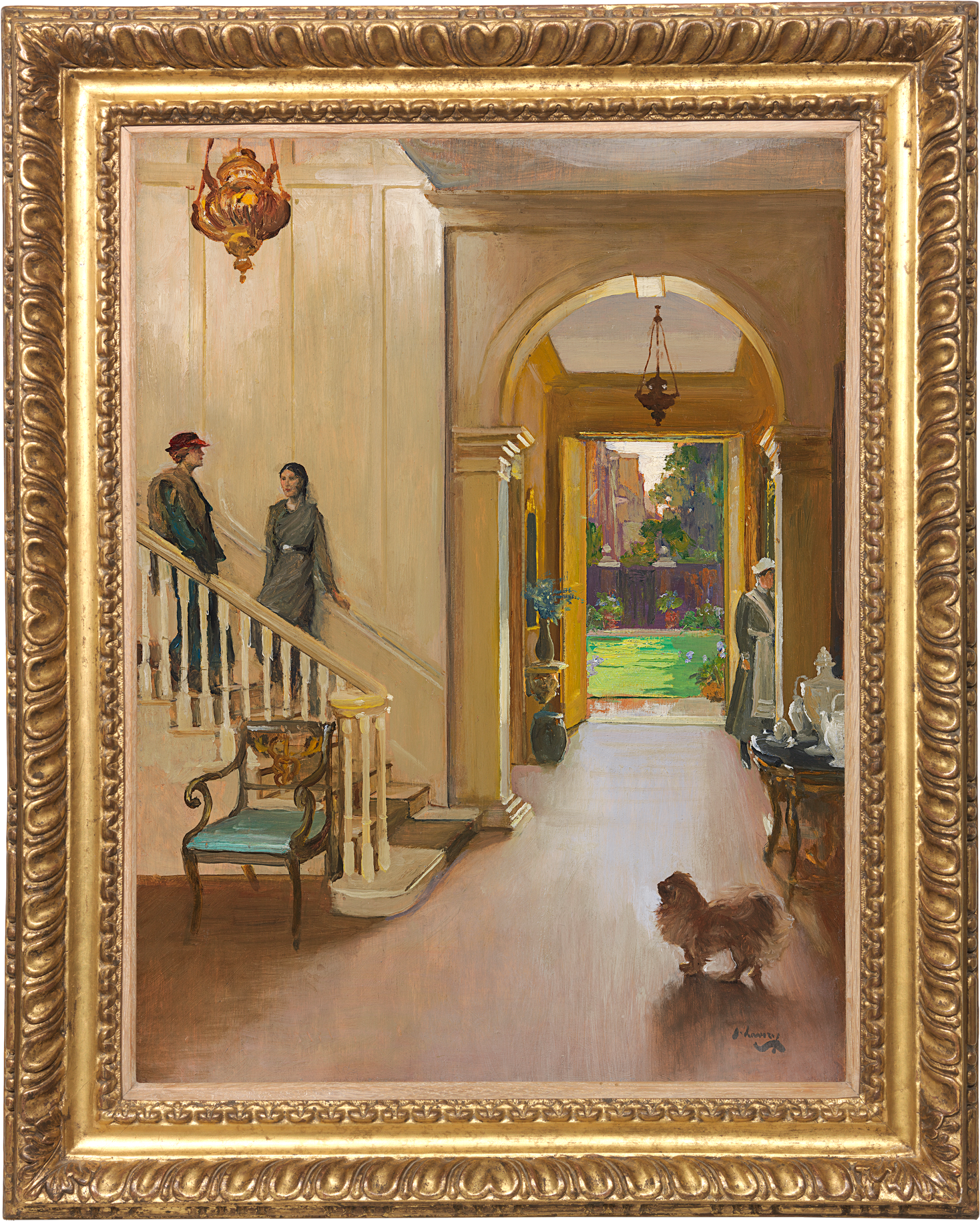SIR JOHN LAVERY RA RSA RHA PRP NP IS
Belfast 1856 - 1941 Kilmaganny, County Kilkenny
Ref: CD 117
The hall, Argyll House - a summer day
Signed lower right: J. Lavery
Oil on panel: 24 x 18 in / 61 x 45.7 cm
Frame size: 30 x 24 in / 76.2 x 61 cm
In an antique carved and gilded raking knull frame
Painted in 1925
Provenance:
Sotheby’s London, 9th November 1988, lot 33
Private collection, UK;
Richard Green, London, 1998;
private collection, UK, acquired from the above in June 1998
Exhibited:
London, Leicester Galleries, Portrait Interiors by Sir John Lavery, October 1925, no.9, as Argyll House New York, Duveen Galleries, Portraits, Interiors and Landscapes, by Sir John Lavery, November-December 1925, no.22, as Argyll House Harrisburg, Art Association of Harrisburg, Paintings by Sir John Lavery, February-March 1926, no.7, as Argyll House Pittsburgh, Carnegie Institute, Portraits, Interiors and Landscapes, by Sir John Lavery, March-April 1926, no.1, as Argyll House Whitehall, Palm Beach, Portraits, Interiors and Landscapes, by Sir John Lavery, January-February 1927, no.16, as Argyll House
Literature:
‘Luxury Shown on Canvas: Sir John Lavery’s Skill’, Daily News, 5th October 1925, p.3 Desmond MacCarthy, ‘Sir John Lavery’s Portrait Interiors’, Apollo, vol. 2, 1925, pp.271-273
Kenneth McConkey, Sir John Lavery, Cannongate Press, Edinburgh 1993, pp.174, 226, illus. pl.209
Chester Jones, Colefax & Fowler: The Best in English Interior Decoration, Barrie & Jenkins London 2000, p.22, illus. in colour
Kenneth McConkey, Sir John Lavery: A Painter and His World, Atelier Books, Edinburgh 2010, p.169
Pauline C Metcalf, Syrie Maugham: Staging Glamorous Interiors, Acanthus Press, New York 2010, illus. in colour p.70
In October 1925, Sir John Lavery staged a small exhibition consisting of twenty-three ‘portrait interiors’ at the Leicester Galleries in London. These took the curious viewer into rooms occupied by prominent figures in the worlds of politics, literature and the arts. Beginning with scenes of Buckingham Palace and the Houses of Lords and Commons, in recent paintings the artist had explored the opulent interiors of the rich and famous. These included the writing rooms of JM Barrie, HH Asquith, and the novelist, Mary Borden as well as interiors in the homes of the ladies Cunard, Wimbourne, Trevor and Colefax, at the Ritz Hotel, Wimbourne House, Coombe Court and, in the present instance, Argyll House. Of these latter works, The Evening News remarked, ‘in every case the interior belongs to its owner, and the owner to the interior. They reflect each other and are welded into absolute unity’.[1]
Lavery had toyed with the concept for many years. Back in the 1880s, his first important interiors such as Finale (fig 1), had addressed rooms in which significant aesthetic signifiers – a Morris-style chair, a Venetian mirror, a Japanese fan – exemplified the taste of the era rather than the individual.
Fig 1 John Lavery, Finale, circa 1885-7, 34 x 46 ¾ in, Sir Tim Rice, photo courtesy Richard Green
A more refined possibility suggested itself in 1909 with The Greyhound, a picture of Sir Reginald Lister’s drawing room at the British Legation at Tangier. Others, including his diploma painting for the Royal Academy, the much-admired Van Dyck Room, Wilton of 1920, followed (fig 2&3).[2]
Fig 2 John Lavery, The Greyhound, circa 1908-9, 25 x 30 ¼ in, National Museums, Northern Ireland
Fig 3 John Lavery, The Van Dyck Room, Wilton, 1920, 25 x 30 in, Royal Academy of Arts, London
Light brought atmosphere into these sumptuous settings as much as colour, tone and structure in the interpretation of space.[3] Standing in the spartan hallway at Argyll House in Chelsea for instance, the eye was instinctively drawn to a glimpse of sky and trees to the rear of the building. Situated on the corner of King’s Road and Oakley Street, these first impressions were of a family home of great distinction.
New research by Anna-Katrina Hastie of ‘Sibyl Colefax & John Fowler’ has revealed that Lavery painted the hall at Argyll House on a sunny spring morning in 1925. This we owe to a letter from Sir Philip Burne-Jones to Sibyl, in which he remarked that having painters in your house was ‘a well-known cause of distress to all house holders’, but to find ‘one painter established upon your doormat when you pass through the hall might cause you to repent your hospitality.’ He even went so far as to provide a sketch from memory of the offending artist (fig 4).[4]
Fig 4 Philip Burne-Jones, The Hall, Argyll House, 1925, Oxford, Bodleian Libraries, MS. Eng. c. 3160
Built in 1723 by the Venetian architect, Giacomo Leoni and one of the first Palladian houses in Britain, its panelled and painted reception rooms followed from a wide hall with a transverse staircase leading to the upper floor, similar to, but smaller than Charlemont House in Dublin.[5] It was, according to Desmond MacCarthy, ‘one of the few London houses you see through on entering’, the garden colours providing a picture-within-the-picture.[6] On the doorstep the caller faced a hall and staircase ‘the colour of old ivory’ that though simple sounding had been difficult to achieve.[7] In that moment of welcome Lavery confronted a play of figures and a dog to the sides of a steep perspective leading to the sunlit lawn. This simple layout produces one of his most striking compositions in which an exchange between two women, one dressed in hat, coat and fox fur, takes place on the stairs, and is observed by an attentive Pomeranian on the right. A maid, overhearing the conversation, hovers at the drawing room door. This is a sunny morning in King’s Road, and it is time to take the dog for a walk.[8]
Numerous contemporary accounts of the activities at Argyll House miss such an everyday scene. Newly fashionable Chelsea, a run-down artists’ quarter in the late nineteenth century, rapidly transformed itself in the early years of the new century, not least as a result of the activities centred in Argyll House when Sibyl Colefax and her husband, Arthur, took up residence in 1921. Married in 1901, the Colefaxes had gained renown for lunches and soirées that included literary lions such as HG Wells, George Bernard Shaw and JM Barrie.[9] By 1910, Arthur Colefax was elected to Parliament, and the couple commuted between houses in Onslow Square and Old Brockhurst in Sussex. Throughout the Great War, however, country house parties were somewhat curtailed and Colefax gave up his lucrative practice to manage the scientific department of the Munitions Ministry pro bono, for which he was knighted in 1920. At this point the Sussex house was sold and Sir Arthur and Lady Sibyl set their hearts on the ‘little country house’ in Chelsea.[10] Their new home quickly acquired greater renown than the house in Onslow Square, attracting a new generation of ‘lions’ and the nickname ‘Lions’ Corner House’ – a reference to the Lyons Corner House cafes that were proliferating after the Great War.[11] In these years its brilliant hostess assumed even greater social caché with the likes of TS Eliot and Virginia Woolf, while other guests included the Trefusises, the Maughams, the Coopers, the Churchills, the Oxford and Asquiths, many of whom had been or had supplied Lavery sitters.[12] For her part, Hazel Lavery, with her reception rooms at Cromwell Place photographed for Vogue and Lady’s Pictorial, seemingly shared some of Lady Colefax’s social and interior decorator ambitions.[13]
Despite their support for the Irish cause and extensive commitments elsewhere, during the early Twenties the Laverys were, nonetheless, very familiar with the house in King’s Road. When the artist went there to paint it in the spring of 1925, he adopted the role of a caller who had arrived unexpectedly.[14] After its showing in London the present panel travelled to New York where at the end of November 1925 it was shown in Lavery’s solo exhibition at Joseph Duveen’s galleries on Fifth Avenue.[15] Sibyl, a friend of Duveen, also travelled to New York at this time and her diary reveals that she saw the Laverys and lunched with Hazel during December.[16] While The Hall, Argyll House - A Summer Day was on tour for the next year, the supper parties and literary lunches continued apace, ‘Chips’ Channon noting a large gathering of 102 guests at the Colefax house, where Hazel Lavery appeared ‘… looking too like her pictures’ (fig 5).[17]
Fig 5 John Lavery, The Green Coat, Hazel Lavery, 1926, 78 x 42 ½ in, National Museums, Northern Ireland
If she was an ornament on such occasions, she was the living embodiment of The Green Coat, Lavery’s current portrait. Such is the sight you might have seen emerging from the ‘headstrong’ Siddeley, the painter’s car, on King’s Road, on the evening or 29 June 1926, when Channon observed her. And her hostess? No address book could compare with hers. As a design consultant she was almost sans pareil and so too was her ability to arrange a perfect pairing at a lunch or dinner table. On such occasions she noted that ‘… a good evening … is what the house really wants and is made for – a little company, full of intimacy and good fellowship …’[18] If Sibyl Colefax brought new life to an old house at these times, it was sunlight on a summer morning that appealed to the painter – that and a dog panting for its mistress.
Kenneth McConkey is the author of Sir John Lavery, a Painter and His World, 2010 and curator of the recent exhibition, An Irish Impressionist: Lavery on Location, held at the National Gallery of Ireland, Dublin, Ulster Museum, Belfast and the National Gallery of Scotland /Royal Scottish Academy, Edinburgh from 2023-24.
[1] ‘People seen at home. Harmonising personality and House. Barrie’s Garret’, Evening News, 3rd October 1925, p.12.
[2] See Kenneth McConkey, Lavery On Location, exh. cat., National Gallery of Ireland, Dublin, 2023, pp.108-9, 170-1. Apart from hospital interiors produced during the Great War in 1917, for instance, Lavery produced the sumptuous Drawing Room, Falconwood, the home of the d’Elangers at Woolwich (Private collection) and the grand saloon at Londonderry House, (Ulster Museum, Belfast).
[3] ‘The Leicester Galleries’, The Observer, 4th October 1925, p.8 observed that to achieve the ‘vital unity of impression…the artist seems far more interested in the shafts of light…[than in] furniture and pieces of bric-a-brac.’
[4] Letter dated 27th March 1925, Bodleian Library, University of Oxford. It is worth noting that Sir Philip’s memory of his visit is slightly at fault. Lavery habitually stood at his easel and the steep perspective of the floor in the painting confirms this. It is nevertheless the case that on such occasions the painter often attracted onlookers – as in the drawing. I am grateful to Ms Hastie for these references.
[5] Kirsty McLeod, A Passion for Friendship, Sibyl Colefax and her Circle, Michael Joseph, 1991, pp.48-52, stresses the Colefaxes’ struggle to acquire Leoni’s masterpiece and their passion to retain and preserve its integrity. See also https://www.british-history.ac.uk/survey-london/vol4/pt2
[6] Desmond MacCarthy, ‘Sir John Lavery’s Portrait Interiors’, Apollo, vol 2, 1925, p.271.
[7] McLeod 1991, p.51.
[8] In 1988 it was suggested that the second figure on the stairs was that of Syrie Maugham, Lady Colefax’s neighbour and ultimately, business rival. The garden at Argyll House faces south, and trees on its east side cast shadows across the lawn, indicating that this is morning sunshine.
[9] Arthur Colefax (1866-1936) was a wealthy patents lawyer from Bradford who stood for Parliament in 1910 and Sibyl (1874-1950) née Halsey, was a daughter of an Indian Civil Servant during the Raj. It was claimed that her place in society was assured after telling Wells and Shaw, without either knowing, that each was keen to meet the other. When the couple’s fortunes dipped after the Wall Street Crash, she set herself up as a successful interior designer and formed a partnership with John Fowler.
[10] Mcleod p.49 indicates that Sibyl had passed the house on Monday mornings on her way to French lessons in Cheyne Row, and fell in love with it.
[11] Simon Heffer ed., Henry ‘Chips’ Channon, The Diaries 1918-1938, Hutchinson, 2021, p.224.
[12] McLeod indicates that the Colefax circle extended to French literati, including André Gide and Paul Valéry, to Italy where Sibyl became friendly with the Berensons and to the United States where she visited the Frick and other private collections (pp.65-6). This latter visit occurred in November 1926, coinciding Lavery’s second exhibition at the Duveen Galleries.
[13] McConkey 2010, p.144. Colefax was undoubtedly more voracious than Hazel and her relentless pursuit of the Sitwells, Virginia Woolf and Evelyn Waugh did her few favours; see John Pearson, Facades: Edith, Osbert and Sacheverell Sitwell, 1978 (Fontana pkb ed), pp.117-8; Hermione Lee, Virginia Woolf, 1997 (Vintage), p.468; Mark Amory ed., The Letters of Evelyn Waugh, 1982 (Penguin), p.172. The Sitwells and Waugh referred to Sibyl as ‘Colebox’.
[14] Although there were other occasions, Lavery makes only one reference to dining chez Lady Colefax in 1925 when Edwin Lutyens questioned his defence of Jacob Epstein’s modernist sculpture, Rima, recently unveiled in Hyde Park, to which the painter replied, ‘My dear Edwin, I have done worse than that. I have been defending the Cenotaph’; John Lavery, The Life of a Painter, 1940 (Cassel), p.127.
[15] Clearly the painting epitomised the ideal English domestic interior for Duveen’s American clients.
[16] I am grateful to Anna-Katrina Hastie, for references to the Laverys in Sibyl Colefax’s New York Diary in the Bodleian Library, Oxford University. When they arrived in New York on 20th November 1925, they found Sibyl was already there.
[17] Channon 2021, p.224. The gathering was also attended by Harold Nicholson who described it as ‘a triumph for Sibyl’; Nigel Nicholson ed., Vita and Harold, The Letters of Vita Sackville-West and Harold Nicolson, 1910-1962, 1992 (Weidenfeld and Nicolson), p.152; see also Elsa Maxwell, I married the World, 1955 (William Heinemann), pp.123-4, who claimed that Sibyl’s patronage of the literary great and good, entailed locking the front door, once her guests had arrived so that they could not easily escape.
[18] McLeod 1991, p.77.

